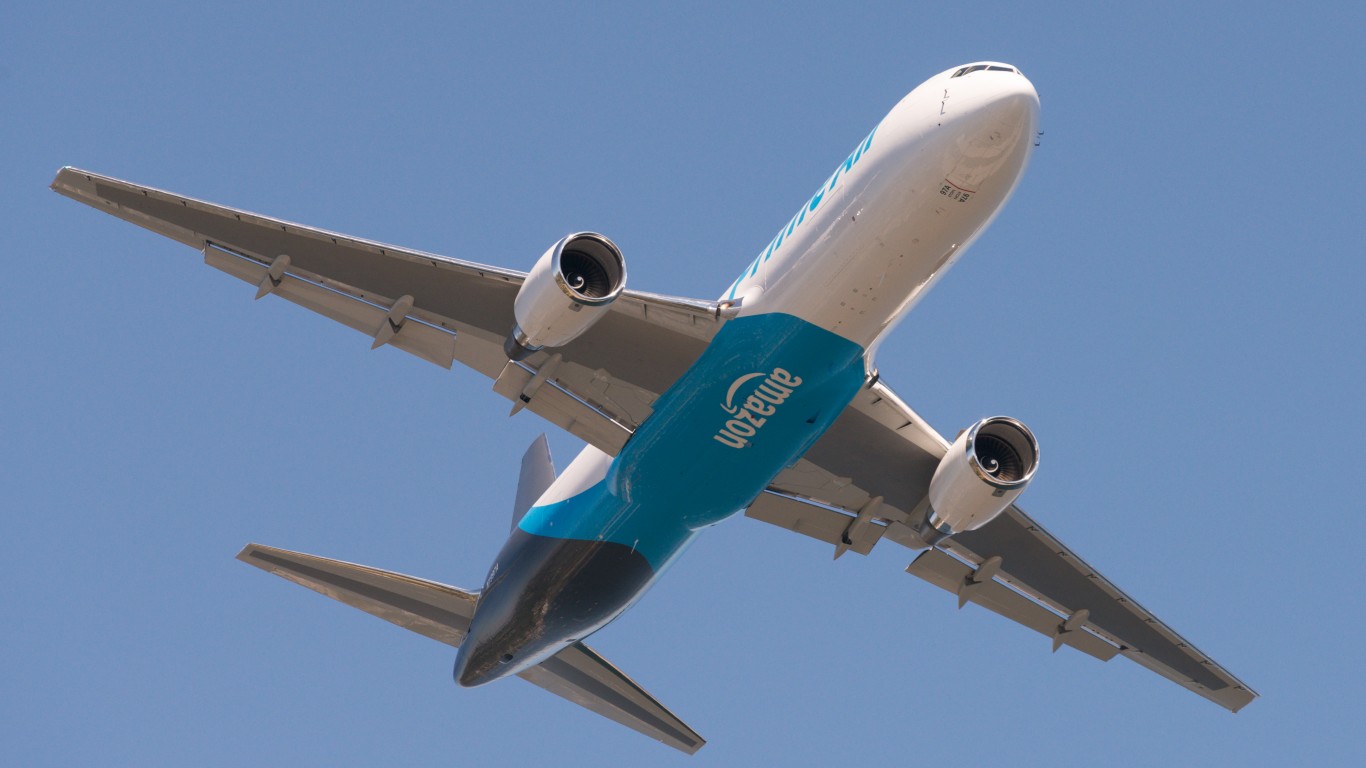
It’s probably no surprise that a company planning to add enough new employees to populate a city with an NFL franchise is also growing in other parts of its business. It’s probably even less of a surprise that the company in question is Amazon.com Inc. (NASDAQ: AMZN).
Amazon added nine aircraft to its Amazon Air operations in the three months from May through July, the most it has ever added in any three-month period before. Flight activity also has increased by more than 30% since April as the fleet has grown, and Amazon Air has improved its utilization of its airplanes.
Researchers at DePaul University’s Chaddick Institute for Metropolitan Development reported the data was last week. They believe Amazon’s fleet could number 200 aircraft by 2028.
The nine aircraft added between May and July are all operated by Sun Country Airlines. Three more planes have been added since then, bringing Amazon’s total fleet to 54 airplanes. The researchers expect the company to add four more planes, perhaps by December, bringing the company’s total of new planes in 2020 to 16, a number equal to Amazon’s 2016 expansion.
Amazon also has increased its daily flight activity from 85 per day on April 23 to 108 per day on August 20. The researchers noted that aircraft utilization rose from 2.02 to 2.12 flights per day between those dates, an improvement of around 4%.
Even more impressively: “Over the six days observed in August, Amazon averaged 2.7 flights per plane, with the 737s being Amazon’s workhorses, averaging 2.8 per day, compared to 2.5 for 767s.” The researchers also noted that where many air-cargo integrators fly just two segments a day (one in each direction from a major hub), they observed that some Amazon planes complete five segments on a single day.
Amazon does not operate its fleet. That is left to five contractors: Atlas Air Worldwide Holdings Inc. (NASDAQ: AAWW), Air Transport Services Group Inc. (NASDAQ: ATSG), Southern Air (a subsidiary of Atlas Air), Sun Country and Worldwide Flight Services, Amazon’s provider of airport services including cargo handling. All Amazon Air planes except one Boeing 767 acquired by Amazon earlier this month are leased either solely by Amazon or jointly with the contract carrier.
The researchers point out that Amazon Air’s business outside the United States is “skeletal,” with occasional flights to Amsterdam and Shanghai. Both, however, are “focal points” for air cargo and logistics in Europe and China, respectively, and more international flights to these and other locations are expected “over the next several years.”
In the United States, Amazon is developing its own hubs at smaller airports like Lakewood Linder in Florida, Ontario International in California and Allentown Lehigh Valley in Pennsylvania. Amazon is “triangulating” the New York City metro by shifting some of its flights from Allentown to New York’s JFK and Hartford’s Windsor Locks Bradley International, giving the company “relatively uncongested” lanes to Albany, Boston and Philadelphia.
Amazon’s expansion announced in 2017 on nearly 1,000 acres at Cincinnati/Northern Kentucky International (called Cincinnati CVG) is nearing completion and is on schedule to open next year. The airport is already DHL’s main operating location and is less than two hours from Indianapolis, the second-largest U.S. hub for FedEx Corp. (NYSE: FDX).
The researchers expect flight operations to expand by another 5% to 8% this year and to fly more international routes, among other things. By mid-2021, Amazon Air’s fleet could expand to 65 or 66 and the Cincinnati CVG expansion will be operational. For comparison, FedEx’s fleet totals about 565 aircraft, and United Parcel Service Inc. (NYSE: UPS) has around 680 planes.
More interesting, perhaps, is an expectation that Amazon will launch domestic service to more small airports that have little passenger traffic. The company has added service to two such airports already, in Lake City, Florida, and Roswell, New Mexico.
By the end of next year, according to the researchers, Amazon Air could be flying more than 200 flights a day, nearly double its size at the beginning of this year. That would require a fleet of around 75 airplanes, easily within Amazon Air’s reach.
Amazon’s stock traded up about 2% early Monday, at $3,179.02 in a 52-week range of $1,626.03 to $3552.25. The consensus price target on the stock is $3,661.68.
Are You Still Paying With a Debit Card?
The average American spends $17,274 on debit cards a year, and it’s a HUGE mistake. First, debit cards don’t have the same fraud protections as credit cards. Once your money is gone, it’s gone. But more importantly you can actually get something back from this spending every time you swipe.
Issuers are handing out wild bonuses right now. With some you can earn up to 5% back on every purchase. That’s like getting a 5% discount on everything you buy!
Our top pick is kind of hard to imagine. Not only does it pay up to 5% back, it also includes a $200 cash back reward in the first six months, a 0% intro APR, and…. $0 annual fee. It’s quite literally free money for any one that uses a card regularly. Click here to learn more!
Flywheel Publishing has partnered with CardRatings to provide coverage of credit card products. Flywheel Publishing and CardRatings may receive a commission from card issuers.
Thank you for reading! Have some feedback for us?
Contact the 24/7 Wall St. editorial team.
 24/7 Wall St.
24/7 Wall St.

